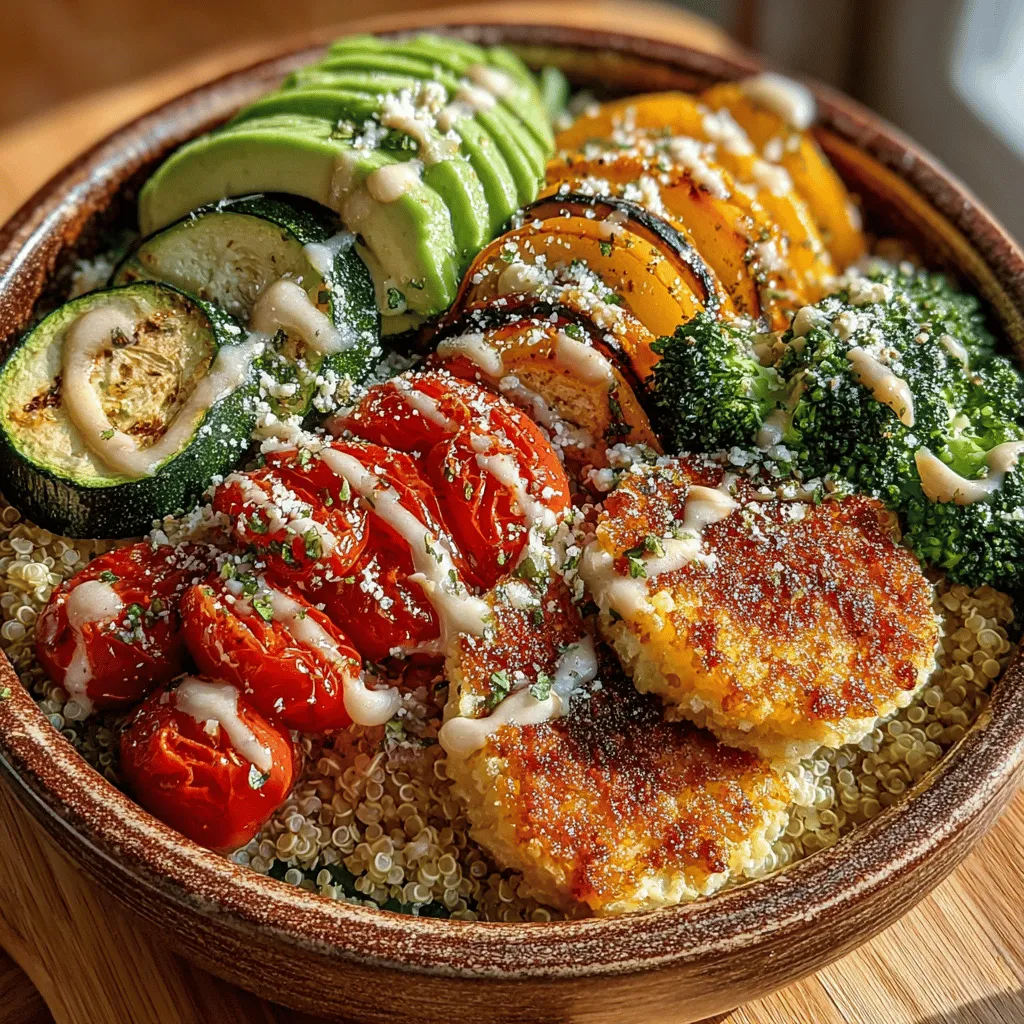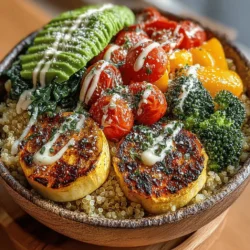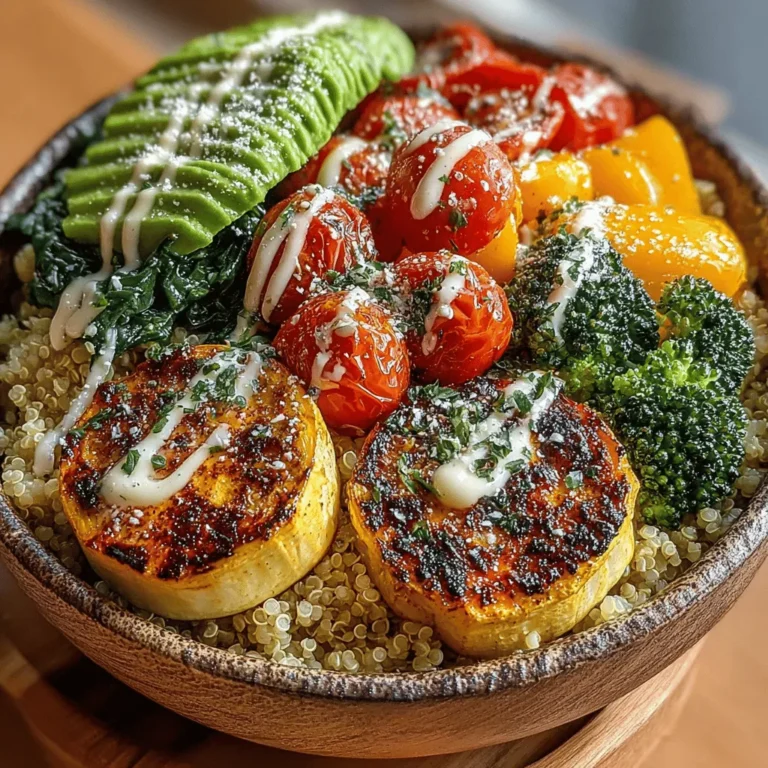Introduction
Quinoa and Roasted Veggie Power Bowls are not only visually stunning but also packed with nutrients, making them an ideal choice for a healthy meal. In our fast-paced world, finding a meal that is both nutritious and delightful can often feel like a challenge. This versatile recipe combines protein-rich quinoa with a colorful array of roasted vegetables, offering a delightful balance of flavors and textures. Perfect for meal prep or a quick dinner, these power bowls can be customized to fit your taste preferences, ensuring that there’s something for everyone.
The appeal of Quinoa and Roasted Veggie Power Bowls lies not only in their taste but also in their health benefits. Quinoa, often hailed as a superfood, serves as the foundation of this dish, providing a wealth of nutrients that support overall well-being. When paired with a medley of seasonal vegetables, this dish transforms into a powerhouse of vitamins, minerals, and antioxidants. In this article, we will delve into the details of creating these bowls, including a breakdown of the ingredients, step-by-step instructions, and insights into their nutritional benefits.
Understanding the Ingredients
*Exploring Quinoa: The Superfood Foundation*
Quinoa is often referred to as a superfood, and for good reason. This ancient grain is gluten-free and boasts a remarkable protein content, making it an excellent choice for those seeking to incorporate plant-based protein into their diets. In addition to being high in protein, quinoa is also rich in essential amino acids, making it a complete protein source—a rarity among plant foods. This makes quinoa particularly appealing for vegetarians and vegans looking to fulfill their protein needs.
To prepare quinoa, start by rinsing it under cold water. This step is crucial as it removes the natural coating called saponin, which can impart a bitter flavor. After rinsing, cook quinoa using a ratio of 2 cups of water for every 1 cup of quinoa, bringing the mixture to a boil before reducing the heat to simmer. Cook for about 15 minutes, or until the quinoa has absorbed the water and the grains have expanded, resulting in a light and fluffy texture.
*The Vegetable Medley: A Burst of Color and Nutrition*
One of the standout features of Quinoa and Roasted Veggie Power Bowls is the vibrant mix of vegetables that can be included. For this recipe, we typically use zucchini, bell peppers, red onion, cherry tomatoes, and broccoli. Each of these vegetables brings its own unique flavor and nutritional profile to the dish.
Zucchini is low in calories yet high in essential nutrients like vitamin C and potassium. Bell peppers add a sweet crunch and are rich in vitamin A and antioxidants. Red onions provide a zesty bite and are known for their anti-inflammatory properties. Cherry tomatoes add a burst of juiciness and are packed with lycopene, a powerful antioxidant. Lastly, broccoli is a nutrient-dense vegetable that offers fiber, vitamins C and K, and a range of phytonutrients. Including a variety of vegetables not only enhances the visual appeal of the dish but also contributes to a balanced diet, ensuring that you receive a broad spectrum of nutrients with every bite.
*Healthy Fats: The Role of Olive Oil and Avocado*
Incorporating healthy fats into your meals is essential for overall health, and in Quinoa and Roasted Veggie Power Bowls, olive oil plays a vital role. This heart-healthy oil is rich in monounsaturated fats, which can help lower bad cholesterol levels and reduce the risk of heart disease. Additionally, olive oil contains antioxidants, including vitamin E and polyphenols, which further support health.
Avocado is another ingredient that elevates the nutritional value of these power bowls. Known for its creamy texture and rich flavor, avocado is an excellent source of healthy fats, fiber, and essential vitamins such as vitamin E and K. Adding sliced or diced avocado to your power bowl not only enhances the taste but also contributes to a feeling of satiety and overall nutritional balance.
*Flavor Enhancers: Seasonings and Dressings*
To elevate the flavors in your Quinoa and Roasted Veggie Power Bowls, seasonings play a crucial role. Garlic powder and smoked paprika are two standout options that not only add depth but also provide unique health benefits. Garlic powder is known for its immune-boosting properties and may support heart health, while smoked paprika offers a rich, smoky flavor that can transform simple vegetables into a culinary delight.
When it comes to dressings, the options are plentiful. A drizzle of tahini can add creaminess and a nutty flavor, while vinaigrettes made from olive oil, vinegar, and herbs can provide a fresh and zesty finish. For those looking for a lighter option, yogurt-based sauces can also complement the flavors beautifully while adding a creamy texture.
Step-by-Step Instructions
*Preparing the Oven and Cooking Quinoa*
Before diving into the preparation of the vegetables, it’s essential to preheat your oven to 425°F (220°C). This temperature is ideal for roasting vegetables, allowing them to caramelize and develop a rich flavor profile. While the oven is heating, you can focus on cooking the quinoa. Following the instructions mentioned earlier, rinse the quinoa thoroughly and then cook it in a saucepan with the appropriate water ratio. Once cooked, fluff the quinoa with a fork and set it aside to cool slightly while you prepare the vegetables.
*Vegetable Preparation: Chopping and Seasoning*
The next step involves preparing the vegetables for roasting. Start by washing and drying all the vegetables thoroughly. For even cooking, it’s important to chop them into uniform sizes. Zucchini can be sliced into half-moons, bell peppers into strips, red onion into wedges, and broccoli into bite-sized florets. Cherry tomatoes can be left whole or halved, depending on your preference.
Once the vegetables are chopped, transfer them to a large mixing bowl. This is the time to add your seasonings. Drizzle the vegetables with olive oil, and sprinkle on garlic powder, smoked paprika, salt, and pepper. Toss everything together until the vegetables are evenly coated in the oil and seasonings. This step ensures that every bite will be bursting with flavor.
*Roasting Techniques for Perfect Vegetables*
Roasting vegetables is an art that can elevate their flavor significantly. To achieve perfectly roasted vegetables, it’s crucial to spread them out in a single layer on a baking sheet. This allows for even cooking and prevents steaming, which can occur if the vegetables are overcrowded.
Place the baking sheet in the preheated oven and roast the vegetables for about 20 to 25 minutes, or until they are tender and slightly caramelized. Halfway through the roasting process, give the vegetables a good stir to ensure they cook evenly. The result should be a beautiful medley of colors, with a slightly crispy exterior and a tender interior, ready to be combined with the quinoa for your power bowls.
By following these initial steps, you are well on your way to creating a delicious and nutritious Quinoa and Roasted Veggie Power Bowl that is sure to impress. In the next part of this article, we will explore additional tips and tricks for assembling your bowls, as well as suggestions for variations and toppings that can make this dish even more exciting.

Assembling the Power Bowls
Creating the perfect Quinoa and Roasted Veggie Power Bowl is all about layering flavors, textures, and nutrients. Here’s how to assemble your bowls for maximum satisfaction and visual appeal.
Building Layers: Quinoa, Roasted Veggies, Greens, and Avocado
1. Start with the Quinoa Base: Begin by placing a generous scoop of cooked quinoa at the bottom of your bowl. This fluffy grain not only acts as a hearty base but also adds a nutty flavor to your meal.
2. Add Roasted Veggies: Next, layer in the roasted vegetables. Aim for a colorful mix—bell peppers, zucchini, carrots, and red onions work beautifully together. This not only enhances the visual appeal but also provides a variety of flavors and textures.
3. Incorporate Fresh Greens: Add a handful of fresh greens, such as spinach, kale, or arugula, on top of the roasted veggies. The greens add a refreshing crunch and are packed with essential vitamins.
4. Top with Avocado: No power bowl is complete without creamy avocado. Slice half an avocado and place it on top of the greens. This will not only elevate the flavor profile but also contribute healthy fats to your meal.
5. Drizzle with Dressing: Finish off your bowl with a light drizzle of your favorite dressing or a squeeze of lemon juice. A simple lemon-tahini dressing or balsamic vinaigrette works wonders.
Creative Ways to Present and Serve the Bowls
When it comes to serving your quinoa and roasted veggie power bowls, presentation can make a significant difference. Here are some creative ideas:
– Use Clear Bowls: Serving in clear glass bowls allows the vibrant colors of the ingredients to shine, making your dish more enticing.
– Layer Ingredients in Jars: For meal prep, consider using mason jars. Layer the ingredients starting with the dressing at the bottom, followed by quinoa, roasted veggies, greens, and avocado on top. Just shake and serve when ready to eat.
– Garnish with Fresh Herbs: A sprinkle of fresh herbs like cilantro, parsley, or basil can elevate the dish’s flavor and presentation.
– Serve with Whole Grain Bread or Pita Chips: Offering an additional side of whole grain bread or crispy pita chips can add a delightful crunch to your power bowl experience.
Nutritional Analysis of Quinoa and Roasted Veggie Power Bowls
Understanding the nutritional benefits of your meal is essential for maintaining a balanced diet. Here’s a breakdown of what makes these power bowls a nutritious choice.
Caloric Breakdown and Macronutrient Composition
Each serving of the Quinoa and Roasted Veggie Power Bowl contains approximately:
– Calories: 450-500 kcal
– Proteins: 15-20 g
– Fats: 15-20 g (mainly from avocado)
– Carbohydrates: 70-80 g
The macronutrient balance is crucial for a well-rounded meal. With a good source of carbohydrates from quinoa and vegetables, healthy fats from avocado, and a decent protein content, these bowls provide sustained energy and satiety.
Importance of Macronutrient Balance in a Meal
A well-balanced meal should include an appropriate ratio of macronutrients. Carbohydrates serve as the body’s primary source of energy, while proteins are essential for muscle repair and growth. Healthy fats help absorb vitamins and provide essential fatty acids. This balance not only keeps you full longer but also supports overall health and wellness.
Vitamins and Minerals: What You Gain
The ingredients in your power bowl are rich in essential vitamins and minerals that contribute to overall health:
– Quinoa: A complete protein source, rich in magnesium, phosphorus, and B vitamins.
– Bell Peppers: High in vitamin C and antioxidants, which boost the immune system.
– Zucchini: A good source of vitamin A, potassium, and fiber.
– Spinach: Packed with iron, calcium, and vitamins A, C, and K.
– Avocado: Rich in potassium, vitamin E, and healthy monounsaturated fats.
These nutrients work synergistically to support various bodily functions, from boosting the immune system to promoting heart health.
Customizing Your Power Bowls
One of the best aspects of the Quinoa and Roasted Veggie Power Bowls is their versatility. Here’s how to adapt the recipe to suit your dietary preferences.
Adapting the Recipe for Dietary Preferences
– Vegan Options: This recipe is naturally vegan, but you can enhance it by adding plant-based protein sources such as chickpeas, black beans, or edamame.
– Vegetarian Variations: For those who consume dairy, consider adding feta or goat cheese for an additional flavor boost.
– Gluten-Free: Quinoa is gluten-free, making this dish suitable for those with gluten intolerance. Ensure any additional ingredients or dressings you use are also gluten-free.
– Alternative Proteins and Toppings: If you’re looking for protein alternatives, try adding grilled chicken, tofu, or tempeh. For toppings, consider pumpkin seeds, sunflower seeds, or a sprinkle of nutritional yeast for added flavor and nutrition.
Seasonal Variations: Using Fresh Produce
Experimenting with seasonal vegetables allows for fresh flavors and vibrant colors. Here are some suggestions:
– Spring: Try asparagus, peas, and radishes for a fresh taste.
– Summer: Incorporate corn, cherry tomatoes, and eggplant.
– Fall: Use roasted butternut squash, Brussels sprouts, and sweet potatoes.
– Winter: Add hearty greens like kale or collards and root vegetables like carrots and parsnips.
Incorporating herbs and spices can also change the flavor profile. Consider adding fresh basil in summer or warm spices like cinnamon and nutmeg in winter.
Meal Prep and Storage Tips
Preparing your power bowls ahead of time can simplify your weekly meal planning. Here are some strategies to make the most of your time.
Preparing Ahead: Making the Most of Your Time
– Batch Cook Quinoa and Veggies: Cook a large batch of quinoa and roast multiple trays of vegetables at once. Store them separately in airtight containers in the refrigerator for up to five days.
– Pre-portion Ingredients: Divide the quinoa, roasted veggies, and greens into individual containers. This way, you can grab a bowl and quickly assemble your meal.
Storage Tips to Maintain Freshness
– Use Airtight Containers: Store your cooked quinoa and roasted veggies in airtight containers to keep them fresh longer.
– Avoid Assembling Bowls Too Early: If meal prepping, keep ingredients separate until you’re ready to eat. This prevents sogginess and preserves the textures of the ingredients.
Reheating Instructions for Leftovers
To enjoy your Quinoa and Roasted Veggie Power Bowls later, follow these reheating tips:
– Microwave: Place the bowl in a microwave-safe dish, cover it with a damp paper towel, and heat for 1-2 minutes until warmed through.
– Oven: Preheat your oven to 350°F (175°C). Place the bowl on a baking sheet and heat for about 10-15 minutes, ensuring the ingredients are heated evenly without drying out.
– Skillet: For a quick option, toss the ingredients in a skillet over medium heat until warmed through, adding a splash of water or broth to maintain moisture.
Conclusion
Quinoa and Roasted Veggie Power Bowls are a delicious and nutritious meal that can be easily customized to suit individual tastes. This recipe not only provides essential nutrients but also encourages creativity in the kitchen. Whether enjoyed fresh or as leftovers, these bowls stand out as a wholesome option for any meal.
Embrace the power of quinoa and vibrant vegetables, and enjoy the benefits of a healthy, satisfying dish that can be made in under an hour. Perfect for meal prep or a quick weeknight dinner, these power bowls are sure to become a staple in your culinary repertoire. So, gather your ingredients, unleash your creativity, and savor the deliciousness of your homemade power bowls today!


